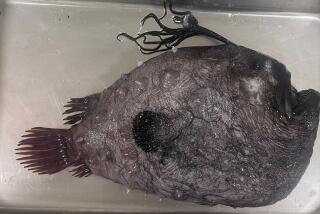Marjorie Courtenay-Latimer, 97; Confirmed Rare Fish’s Existence
- Share via
The creature was 5 feet long, weighed 127 pounds, had iridescent blue armor-like scales, limb-like fins and “a strange little puppy dog tail.”
A South African prime minister pronounced it “ugly,” but Marjorie Courtenay-Latimer said, “It was the most beautiful fish I had ever seen.”
What they were observing was a coelacanth (pronounced SEEL-a-canth), seen in fossils dating back more than 150 million years and last believed to have been swimming around some 70 million years before she spotted it.
Courtenay-Latimer, an amateur ichthyologist who ended the rumors of the fish’s extinction when she saw one wriggling in 1938, died May 17 in East London, South Africa, after a long illness. She was 97.
Before Courtenay-Latimer was born in Aliwal North, South Africa, her mother and railway worker father hoped the child would love nature.
Courtenay-Latimer became the founding curator of the Museum of East London, a coastal South African city, in 1931. Over her long career, she helped excavate a 170-million-year-old skeleton of a mammal-like reptile called Kannemeyeria simocephalus, and helped preserve what may be the world’s only dodo egg and the oldest human fossil footprints. She wrote widely on natural phenomena, from bird and plant species to indigenous cultures.
But her greatest achievement unquestionably was her work with the coelacanth.
The specimen she first saw more than 65 years ago, named Latimeria chalumnae in her honor, remains on display in her museum, along with the Kannemeyeria simocephalus skeleton.
Her efforts have been recorded in two books about the prehistoric fish -- “Old Fourlegs” (1956) by South Africa’s Rhodes University chemist and ichthyologist J.L.B. Smith, and “A Fish Caught in Time: The Search for the Coelacanth” (1999) by Samantha Weinberg.
Summoned Dec. 22, 1938, by a trawler captain who had found a peculiar fish among the day’s 1 1/2-ton catch of sharks, Courtenay-Latimer had suspicions but was uncertain about the find. So she worked to preserve the specimen until Smith could return from Christmas vacation to bolster her theory.
After the local hospital morgue and other refrigeration facilities turned her away in disgust, she reluctantly sought the help of a taxidermist. By using formalin, they preserved the oddity’s skin and bones, but had to discard the soft inner organs.
With Smith’s help, Courtenay-Latimer identified the coelacanth, and Smith posted a reward for any other specimens found alive. Along with the search, a debate raged for years about whether the coelacanth, whose ancestors seemed to have crawled out of the ocean on fins about to develop into legs, was the “missing link” in evolution. That theory was later discarded.
Other coelacanths were discovered for Smith to study in 1952 near the Comoros Islands between Madagascar and Mozambique. More recently, in 1997, American biologist Mark Erdmann found another coelacanth on sale in a fish market in Sulawesi, Indonesia.
Over the years, the not-really-extinct fish was hunted toward extinction, as black market prices escalated to $2,000 per ounce. The hunt was driven by aquariums seeking live coelacanths and Chinese herbal medicine practitioners who believed that a drop of notochord fluid from a fish that has coexisted with both dinosaurs and humans could provide immortality.
The pursuit over the decades prompted Courtenay-Latimer to utter the closing comment in Weinberg’s book, “Perhaps now it is time to leave the coelacanth in peace.”










